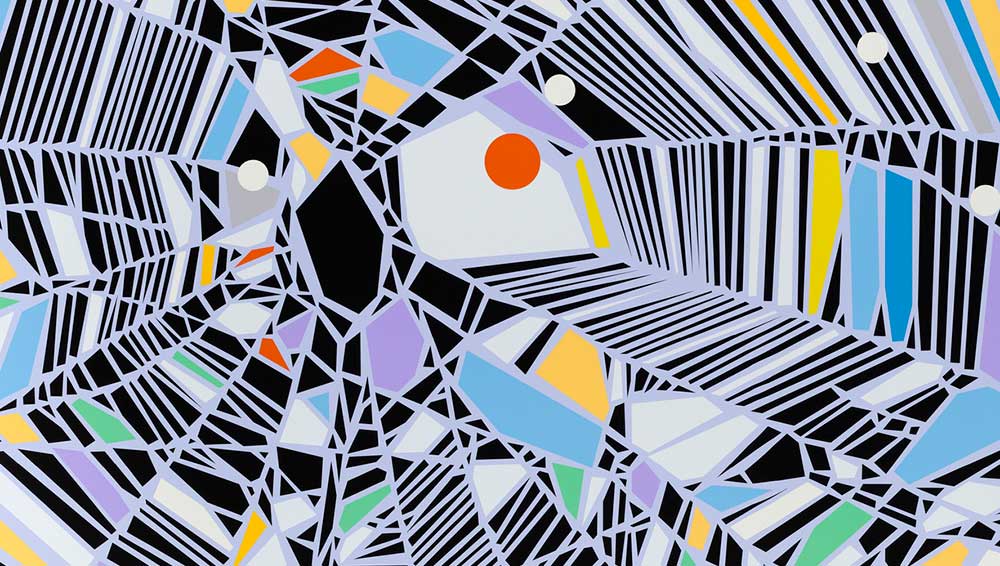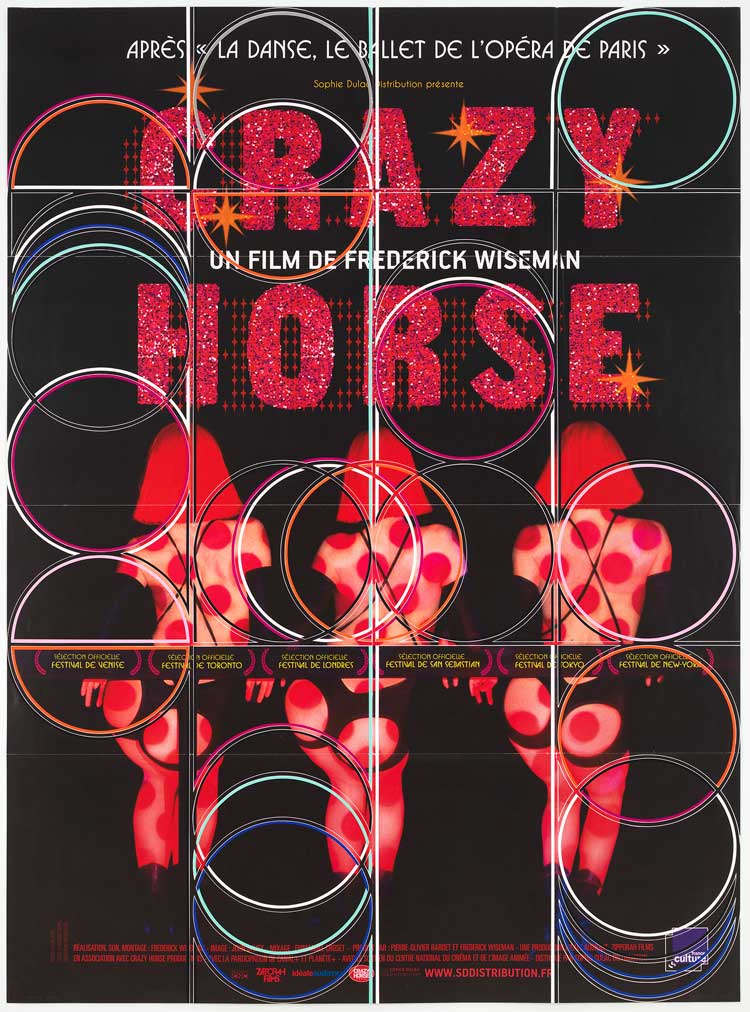
Sarah Morris. Patrol [Spiderweb], 2021 (detail). Household gloss paint on canvas, 84 1/4 x 106 11/16 in (214 x 271 cm). © Sarah Morris. Photo © White Cube (Tom Powel Imaging).
White Cube, Bermondsey, London
19 November 2021 – 9 January 2022
by BETH WILLIAMSON
This exhibition of work by Sarah Morris (b1967) is a dazzling triumvirate of artworks that act to enhance one another: first, Morris’s Spiderweb series of paintings; second, her film Sakura (2018); and, finally, her film poster drawings. Morris is interested in the psychology and perception of time and space, so how do these three bodies of work explore that interest?
-Sumo.jpg)
Sarah Morris. Sakura (still) 2018. HD digital video, 50 min 6 sec. © Sarah Morris.
In her Spiderweb series, Morris uses household gloss paint in her signature palette. The paintings’ smooth, shiny surfaces are at odds with the spiderweb structures that fragment those surfaces. Dots and shards of colour create optical effects that cause segments to appear as if receding or advancing before our eyes. This disruption of perception and understanding is disorienting and somewhat bewildering. The tangle of thoughts, feelings and experiences that emerge when we stand in front of paintings such as Dilemma [Spiderweb] or Ranger [Spiderweb], both painted in 2021, makes complete sense when we realise that Morris created them in response to her experience of the pandemic and lockdown.
![Sarah Morris. Dilemma [Spiderweb], 2021. Household gloss paint on canvas, 214 x 271 cm (84 1/4 x 106 11/16 in). © Sarah Morris. Photo © White Cube (Tom Powel Imaging) Courtesy White Cube.](/images/articles/m/025-morris-sarah-2021/Sarah-Morris-Dilemma-Spiderweb-2021-1.jpg)
Sarah Morris. Dilemma [Spiderweb], 2021. Household gloss paint on canvas, 214 x 271 cm (84 1/4 x 106 11/16 in). © Sarah Morris. Photo © White Cube (Tom Powel Imaging) Courtesy White Cube.
With unfamiliar social habits, restrictions on movement and partial confinement to home, Morris’s spiderwebs seem to suck us in, while simultaneously throwing us to the outer edges of the space in which we find ourselves. In the aptly named Trap [Spiderweb] (2021), for instance, the small black centre of the web structure seems to suck us into the depths of a vortex of shape and colour while, simultaneously, throwing us to the dark outer edges of the image.
![Sarah Morris. Trap [Spiderweb], 2021. Household gloss paint on canvas, 152 x 152 cm (59 13/16 x 59 13/16 in). © Sarah Morris. Photo © White Cube (Tom Powel Imaging).](/images/articles/m/025-morris-sarah-2021/Sarah-Morris-Trap-Spiderweb-2021.jpg)
Sarah Morris. Trap [Spiderweb], 2021. Household gloss paint on canvas, 152 x 152 cm (59 13/16 x 59 13/16 in). © Sarah Morris. Photo © White Cube (Tom Powel Imaging).
The artist says her paintings construct “an internal, imaginary, spatial sense that is slow, precise and quite open […] a set of images and realities that haven’t been made before”. That description might equally apply to the new reality created by Covid-19, a disruption to what we thought we understood about the world and our place in it. Morris’s spiderwebs give visual form to that disruption in a way that continually shifts, a riposte to any firm ground we might cling to.
-Sakura.jpg)
Sarah Morris. Sakura (still) 2018. HD digital video, 50 min 6 sec. © Sarah Morris.
Morris’s film Sakura is set at the time of the blossoming of the Sakura tree, a cherry blossom that symbolises renewal and optimism in Japanese culture. The transient nature of the tree’s blooms also links to the Buddhist ideas that acknowledge the beauty and mortality at the heart of life. In Osaka, where this film was shot, the trees bloom in early to mid-April. The film’s soundtrack is mesmerising. There is such a range of sites, and sights, among the film’s footage, all interspersed with shots of the blossoming Sakura tree. Sites of significance in the film include: the Sakura pastel factory; the National Museum of Ethnology; the Unesco world heritage site of the Bunraku puppet theatre; Renzo Piano’s Kansai international airport; the Suntory Yamazaki whiskey distillery; and the laboratory of Dr Shinya Yamanaka, a Nobel prize-winning scientist. The sights, or film shots, include many inherent contradictions among them. The soft slow blowing blossom in the air is set against the mechanisation of mass production. Scenes of pole dancing precede scenes of women in traditional Japanese dress. Skyscrapers are juxtaposed against the traditional tiered towers of a pagoda.
-Good-morning-Asahi-TV-show.jpg)
Sarah Morris. Sakura (still) 2018. HD digital video, 50 min 6 sec. © Sarah Morris.
The puppet theatre is seen alongside other shots of contemporary television presenters dressed in cartoonish rabbit costume, and seas teeming with jelly fish give way to public transport systems teeming with passengers. Documentary and fiction come together in a film that also immerses the viewer in the micro and macro of scenes, in real and constructed time. All in all, the dichotomies it highlights appear all the more extreme in the wake of the global pandemic.

Sarah Morris. Crazy Horse, 2013. Ink and gouache on paper, 157.6 x 115.7 cm (62 1/16 x 45 9/16 in). © Sarah Morris. Photo © Christopher Burke, New York Courtesy White Cube.
Morris’s film poster drawings lend a third dimension to this exhibition. Once again, there are contradictions at their heart, but dealt with differently this time. The artist has long been fascinated by film posters and these works, bringing original posters together with drawing and diagrams, demonstrate methods of communication, distribution and advertising, something that Morris underlines with the networks of lines and circles on the surface of these posters. They are also full of political and historical references, something that Morris’s selection of foreign language films adds to. The films are chosen deliberately with a focus on those that deal with conspiracy, power structure and networks, as does Morris’s work. Examples here include Crazy Horse, Network, Dr Strangelove, Scanners, Exodus and The Conversation.

Sarah Morris. Network. Ink and gouache on paper, 72.7 x 51.3 cm (28 5/8 x 20 3/16 in). © Sarah Morris. Photo © Christopher Burke, New York Courtesy White Cube.
Everything in this exhibition gestures to living, breathing cities, communities and networks of one sort or another, whether cultural, industrial, commercial or educational. After the enforced time apart of the pandemic when all those networks were broken, Morris’s work shows how important they are for our existence, while simultaneously demonstrating their fragility. Further, larger, more all-encompassing networks underpin everything so that even the semiotics of graphics used in the film poster drawings are geographically contextual and shot through with historical and political referents. Morris’s practice of overlaying original posters with graphics suggests to me not only the recognition of existing networks, but the development of new ones. As a mode of communication, artworks have a potent part to play in potential new networks and Morris’s work in this exhibition stands as a timely reminder of that.